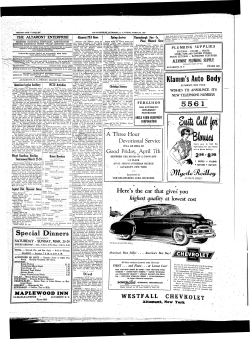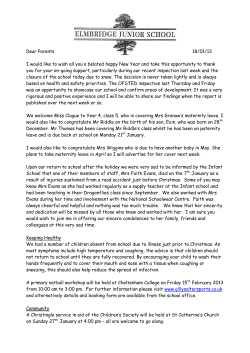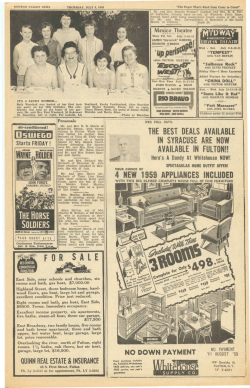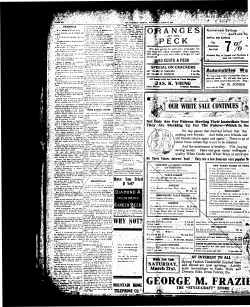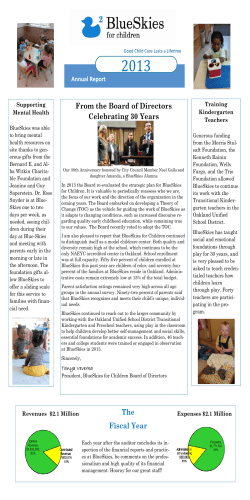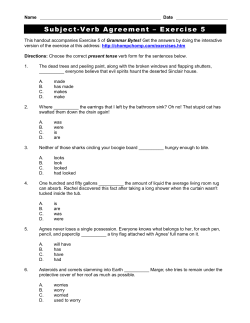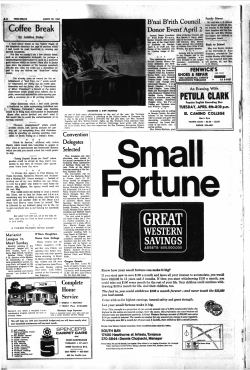
Applying Quality Management in Healthcare: A Systems Approach,
This is a sample of the instructor resources for Applying Quality Management in Healthcare: A Systems Approach, Third Edition, by Diane L. Kelly. This sample contains the instructor notes and PowerPoint slides for Chapter 4 and the answer key to Exercise 3 in Section III. The complete instructor resources consist of 134 pages of instructor’s notes including answers to the Section III exercises, 100 PowerPoint slides, and 15 pages of speaker’s notes on the PowerPoint slides. If you adopt this text you will be given access to complete materials. To obtain access, e-mail your request to [email protected] and include the following information in your message: • Book title • Your name and institution name • Title of the course for which the book was adopted and season course is taught • Course level (graduate, undergraduate, or continuing education) and expected enrollment • The use of the text (primary, supplemental, or recommended reading) • A contact name and phone number/e-mail address we can use to verify your employment as an instructor You will receive an e-mail containing access information after we have verified your instructor status. Thank you for your interest in this text and the accompanying instructor resources. INSTRUCTOR’S MANUAL CHAPTER 4 VISUALIZING SYSTEM RELATIONSHIPS: MODELS FOR HEALTH SERVICES MANAGERS Chapter 5 from the second edition has been relocated to be Chapter 4 in the third edition and the end of chapter exercises has been changed. Second edition, Chapter 5, Exercise 1 has been moved to the Practice Lab of the third edition and renamed to Exercise 5: System Relationships. Second edition, Chapter 5, Exercise 2 has been moved to the Practice Lab of the third edition and renamed to Exercise 6: Systems Error Case Study and Analysis and has been updated with a new case study and a detailed worksheet. Using the Second Edition Chapter 5 exercises repeatedly in the academic setting, revealed that students tend to have difficulty matching the error to its appropriate level of the organization. The new end of chapter exercise provides specific error statements as examples as well as aide students in identifying the level of the organization in which the error occurred. A table has been added to provide more structure to this exercise. Correct responses are provided in the table. Category/Type of Failure Latent error at the level of senior decision makers o o o Latent failures at the level of frontline management o o Circumstances or conditions present when the patient’s accident occurred. o o o Error No staff available for the two people calling in sick. (Lack of a comprehensive staffing plan for the entire hospital) Decision to upgrade CT scanner over modernizing patient beds. Lack of training for nurses about specialized needs of elderly patients, especially related to their responses to medications. (lack of adequate resources allocated for ensuring staff competencies in this area) Night shift was consistently scheduled with the minimum staff needed on this unit. (this could also be considered at the level of senior management due to inappropriate resource allocation, not monitoring performance, lack of ensuring competency of the clinical department manager and / or not maintaining accountability of the department manager) Bioengineering had skipped last month’s preventive maintenance check on the call light system because they were six weeks behind on their work. (this also could be considered at the level of senior management due to lack of appropriate resource allocation, lack of monitoring performance, and / or lack of maintaining accountability of the Bioengineering manager) One nurse and one nurse aide absent due to illness that night. Clara’s age. Clara’s son went home to sleep [Clara was without constant presence of her son]. Active errors associated with this event o Three new patients were admitted to this unit from the Emergency Department between 7:00 pm and 10:00 pm. o Falls risk assessment not completed on patient’s chart. o Falls precautions not implemented for this patient. RECOMMENDED SECTION III COMPANION EXERCISES: Exercise 5; Exercise 6 with supplemental resources APPLYING QUALITY MANAGEMENT IN HEALTHCARE: A SYSTEMS APPROACH Chapter 4 Simple System Inputs Conversion Process Outputs Open Feedback System Inputs Conversion Process Feedback Outputs Quality Management: Open Feedback System Improve Inputs Improve Conversion Process Feedback Outputs Quality Management: Healthcare Inputs Conversion Process Outputs Health Technology Assessment Practice guidelines Process improvement Work simplification Policy (immunizations) Tracking and Monitoring Outcome Measures Individual, organizational, state, national Health status Business status Medical Personnel Licensure Continuing education Performance reviews Technology Clinical trials Governmental bodies Standards Facilities and Structures Inspections Standards and guidelines Three Core Process Model Administrative Decision-Making Processes Desired Results: Clinical/Medical Processes Patient Flow/Operational Processes Administrative Decision-Making Processes Clinical outcomes Functional status Satisfaction Cost Baldrige Performance Excellence Program http://www.nist.gov/baldrige/ Baldrige Framework: A Systems Perspective Source: National Institute of Standards and Technology. 2011“2011-2012 Baldrige Performance Excellence Program Healthcare Criteria for Performance Excellence.” [Online information; retrieved 1/30/11]. http://www.nist.gov/baldrige/publications/hc_criteria.cfm James Reason Error “all those occasions in which a planned sequence of mental or physical activities fails to achieve its intended outcome” Reason, J. 1990. Human Error. Cambridge, UK: Cambridge University Press. Types of Errors Judgment Errors Execution Errors Errors of Omission Errors of Commission Active Errors Latent Errors Violation “deviations from safe operating practices, procedures, standards, or rules” Reason J. 1997. Managing the Risks of Organizational Accidents. Hampshire, UK: Ashgate Publishing Company. Types of Violations Routine violations Optimizing violations Situation violations Errors vs. Violations Errors Where The mind (cognitive) Why Informational problem Prevention Improve knowledge and information Violations Organizational context Motivational problem Address motivational and organizational factors Reason’s Systems Model of Organizational Accidents Socioecological Framework: Determinant Intervention Evaluation / Impact Evaluation / Outcome Indivividual Organizational Health and Health Behaviors Community Population Source: Reprinted with permission by JoAnne Earp, Sc.D.; Peter Reed, M.P.H.; and the instructors of HBHE 131, Introduction to Social Behavior in Public Health, Department of Health Behavior and Health Education, University of North Carolina at Chapel Hill, School of Public Health, 2001. Systems Error Case Study and Analysis Levels of the System Organizational Leadership Frontline Employee External Environment Frontline Management SECTION III EXERCISE 3 DYNAMIC COMPLEXITY The objective of this exercise is to practice identifying dynamic complexity surrounding a patient care experience to increase students’ ability to observe the subtle characteristics of dynamic complexity. This exercise will challenge students to appreciate the patient’s encounter within the context of the larger healthcare system and to introduce system implications associated with management decisions. The case is based on actual events and represents a composite of the root-cause analyses done on several patients who experienced hospital-acquired infections. The table below presents responses to the questions about the case. Sterman is a regarded expert in this field. His article in the Exercise 3 instructions is highly recommended as he provides different explanations of the terms that some students may prefer. System characteristic Changing Tradeoffs Tightly coupled How this was expressed in Mrs. B’s Story • • • • Physiologic changes associated with aging Mrs. B’s changing clinical condition Changes with Mrs. B’s insurance benefits Economic changes, such as increasing dollar amount of the copayment • Insurance company tradeoff: lower price of preferred drug with patient or physician preference • Mrs. B’s known or unknown tradeoff: choosing least-expensive medication with changing to an unfamiliar medication • Physician tradeoff: treatment with a medication that had been effective with Mrs. B with following the conditions of the Pharmacy Benefit Plan This characteristic may not be readily recognizable in the care system, but it may be illustrated in the Mrs. B’s physiological status: (Comments to instructors: Some readers might view this example as a “stretch;” however, it is included because an understanding of both physiology and biochemistry are fundamental to clinical care providers’ education. Pathophysiological relationships and biochemical reactions may be thought of as “tightly coupled.” As a result, some care providers may understand organizational characteristics related to tight coupling on an intuitive level, yet find it difficult to communicate to managers and administrators who do not share this common education base.) • Medication reactions like the one seen between Mrs. B’s blood pressure medication and pain medication may be thought of as tightly coupled, based on the strong interaction exhibited between these two pharmacological compounds • Time-dependent connections may be seen in the condition of 1 History dependent Nonlinear orthostatic hypotension—that is, moving too quickly from lying flat in bed to an upright position, resulted in light headedness, which caused Mrs. B. to faint, which in turn caused her to fall (Comments to instructors: Discussion around the boundaries of the “healthcare system” may be interesting here—that is, does the system include the patient? How do characteristics of the patient as a system influence how the organization as a system is managed?) • The relationship of the steps of the process: physician ordering, pharmacy dispensing, and insurance company paying could also be considered tightly coupled. • Mrs. B’s health history includes hypertension and osteoporosis • Mrs. B’s health behavior history of treating her own minor conditions with over-the-counter medication and/or home remedies • Mrs. B’s socioeconomic history of being a widow on a fixed income • Physician practice patterns over time • Relatively benign action of Mrs. B’s treating her cough with over-the-counter medication set into motion a sequence of events that eventually led to her deteriorating clinical condition • Relatively benign decision of a several dollar change in insurance-payment benefit set in motion a sequence of events that eventually resulted in Mrs. B’s death (Comment to instructors: Once again, some may view this example as a “stretch;” the intent is to illustrate this characteristic of nonlinearity in healthcare organizations; usually, individuals do not have the opportunity to be aware of consequences of their actions that may occur outside the boundaries of their particular subsystem; whether individuals are aware of them or not, these consequences will still be present.) EXAMPLE STUDENT RESPONSE Here are actual student responses to the exercise. The examples are published here with permission from the students: Carolyn Poe, RN, BSN, MPH and Daniel Nissman, MD, MPH., MSEE. Example 1 Name: Daniel Nissman Date: February Chapter 4, pp 70-71. 1. Explain how the following system characteristics expressed themselves in this case. Change – patient’s insurance changed to use pharmacy benefits management and a formulary that did not include the medication the patient was on. 2 Trade-offs – a trade-off between maintaining low cost was made at the expense of increased/unknown side-effects History dependency – this is represented by the patient’s pre-existing osteoporosis and risk for fractures Tight coupling – BP med (ACE?) cough osteoporotic fracture pain taking OTC pain meds interaction with BP medication Nonlinearity – the seemingly “benign” switch to a formulary drug resulted in a cascade of events that resulted in the patient’s death. The effect is clearly not proportional to the cause. Exercise Addendum Name:__Daniel Nissman Date: February Explain how the following system characteristics expressed themselves in this case. Tight coupling – BP med (ACE?) cough osteoporotic fracture pain taking OTC pain meds interaction with BP medication Thoughts about tight coupling: First of all, the examples listed in the chapter are procedural. However, if you extend the definition of tight coupling to a “series of events where the next event/happening is highly predictable based on the previous event” then we can extend the examples to include drug interactions. (Codes, although driven by protocol, rarely proceed exactly according to the protocol, so there is not a 100% linkage between successive steps.) There are two possible pain med/BP med interactions that are fairly predictable that I can think of: 1. morphine and any BP med causing vasodilation orthostatic hypotension 2. any NSAID + ACE inhibitor can cause renal failure by inhibiting the afferent and efferent arterioles feeding the glomeruli orthostatic hypotension It is likely this woman experienced #2. A second mechanism of tight coupling could be: Orthostatic hypotension fall; and then fall + osteoporosis hip fracture. These are not 100% couplings, but they are highly predictable. It’s not clear that there was any procedural tight coupling that led to this woman’s demise (except for the insurance company wants to save money and therefore the patient gets screwed). Example 2 Name: Carolyn Poe Date: February Change: 1. Mrs. B.’s insurance company contracted with a pharmacy benefits management company (PBM), thereby leading to a change in the insurance company’s drug formulary, which led to a change in the medication that Mrs. B. was taking for her hypertension. 3 Tradeoffs: 1. Unless she wanted to pay five times more than she had been, Mrs. B. had to stop taking the anti-hypertensive drug she had been taking for the previous 10 years. 2. The physician felt compelled to switch Mrs. B. from a medication that he was familiar with to one he wasn’t as familiar with so that Mrs. B. could afford to continue receiving treatment for her hypertension. History dependency: 1. This is not exactly clear in this case in regards to the insurance company and their new relationship with the PBM; one can assume that as part of a dynamic system, the insurance company was trying to save money, either as a result of a decision made previously, or as part of a forward going effort to cut costs. 2. The long-standing relationship between Mrs. B. and her doctor, who had an understanding of her co-morbid condition (osteoporosis) as well as her prior response to the drug. Tight coupling: 1. To some degree, the relationship between the insurance company and the PBM and the relationship between the PBM and the pharmacist(s) who would be put in the position of telling their customers that they could no longer get the same prescriptions that they’d been getting for the same price (undoubtedly, Mrs. B. wasn’t the only person to be affected). 2. The relationship between the pharmacist and the physician. The pharmacist interacted with the physician to try to come up with a viable alternative for Mrs. B. Non-linearity: 1. The effect of the cost-cutting measure by the insurance company that ultimately led to the death of Mrs. B. The two are seemingly unconnected but ultimately the decision of the insurance company contributed to Mrs. B.’s broken hip and subsequent long, complicated, and expensive hospitalization. 4
© Copyright 2025
